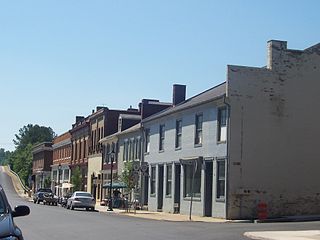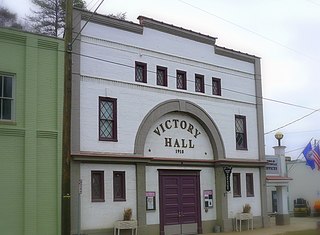
Fluvanna County is a county located in the Piedmont region of the Commonwealth of Virginia. As of the 2020 census, the population was 27,249. Its county seat is Palmyra, while the most populous community is the census designated place of Lake Monticello.

Albemarle County is a county located in the Piedmont region of the Commonwealth of Virginia. Its county seat is Charlottesville, which is an independent city and enclave entirely surrounded by the county. Albemarle County is part of the Charlottesville Metropolitan Statistical Area. As of the 2020 census, the population was 112,395.

Scottsville is a town in Albemarle, Buckingham and Fluvanna counties in the U.S. state of Virginia. The population was 566 at the 2010 census. It is part of the Charlottesville Metropolitan Statistical Area.

The James River is a river in the U.S. state of Virginia that begins in the Appalachian Mountains and flows 348 miles (560 km) to Chesapeake Bay. The river length extends to 444 miles (715 km) if one includes the Jackson River, the longer of its two source tributaries. It is the longest river in Virginia. Jamestown and Williamsburg, Virginia's first colonial capitals, and Richmond, Virginia's current capital, lie on the James River.

Point of Rocks is an unincorporated community and census-designated place (CDP) in Frederick County, Maryland, United States. As of the 2010 census it had a population of 1,466. It is named for the striking rock formation on the adjacent Catoctin Mountain, which was formed by the Potomac River cutting through the ridge in a water gap, a typical formation in the Appalachian Mountains. The formation is not visible from the town and can only be seen from boats on the river, or from the southern bank of the river in Virginia.

The Battle of Rio Hill was a skirmish in the American Civil War in which Union cavalry raided a Confederate camp in Albemarle County, Virginia.
The Valley campaigns of 1864 began as operations initiated by Union Lieutenant General Ulysses S. Grant and resulting battles that took place in the Shenandoah Valley of Virginia during the American Civil War from May to October 1864. Some military historians divide this period into three separate campaigns. This article considers them together, as these campaigns interacted and built upon each other.
The Battle of Saint Mary's Church was an American Civil War cavalry battle fought on June 24, 1864, as part of Union Lt. Gen. Ulysses S. Grant's Overland Campaign against Confederate Gen. Robert E. Lee's Army of Northern Virginia.

State Route 6 is a primary state highway in the U.S. state of Virginia. Known for most of its length as River Road, the state highway runs 102.26 miles (164.57 km) from U.S. Route 250 in Afton east to SR 161 in Richmond. SR 6 is one of the main highways of mountainous Nelson County, where the highway runs north–south from its beginning to US 29. From Scottsville to Richmond, the state highway parallels the James River. SR 6 is a major suburban highway through southwestern Henrico County and the main street of Richmond's West End.

The Rivanna River is a 42.1-mile-long (67.8 km) tributary of the James River in central Virginia in the United States. The Rivanna's tributaries originate in the Blue Ridge Mountains; via the James River, it is part of the watershed of Chesapeake Bay.

The Rockfish River is a 28.7-mile-long (46.2 km) tributary of the James River in central Virginia in the United States. Via the James River, it is part of the watershed of the Chesapeake Bay.

Westham was an unincorporated town in Henrico County, Virginia. It is located in the present day area of Tuckahoe, Virginia. Westham was built at a transportation point on the James River. The James River flows free for several hundred miles from the west and Westham is located at the point where the Fall Line rocks prevented further river passage. Richmond, Virginia was built on the other side of the fall line where the river is navigable to the ocean. This made Westham the first destination for iron used in Revolutionary War. In later years, Canals and then Rail transport connected Westham to Richmond along the James River trade route. Westham was eventually absorbed into Richmond.
Hatton Ferry is a poled cable ferry located 5.5 miles west of Scottsville, Virginia on the James River. It is the last poled ferry in the United States. The ferry crosses the river upstream of Scottsville between Albemarle County and Buckingham County.
The Battle of Meadow Bridge was an engagement on May 12, 1864, in Henrico County, Virginia, during Lt. Gen. Ulysses S. Grant's Overland Campaign of the American Civil War. Following their victory at the Battle of Yellow Tavern on May 11, Union cavalry under Maj. Gen. Philip H. Sheridan advanced in the direction of the Confederate capital of Richmond. Caught in the narrow area between the fortifications of Richmond and the rain-swollen Chickahominy River, the Union troopers were subjected to fire from the artillery of Confederate Maj. Gen. Fitzhugh Lee. Michigan cavalry under Brig. Gen. George A. Custer forced a crossing of a damaged railroad bridge, which was quickly rebuilt by engineers, allowing the troopers to escape to safety and continue their raid.

The First Battle of Deep Bottom, also known as Darbytown, Strawberry Plains, New Market Road, or Gravel Hill, was fought July 27–29, 1864, at Deep Bottom in Henrico County, Virginia, as part of the Siege of Petersburg of the American Civil War. A Union force under Maj. Gens. Winfield S. Hancock and Philip H. Sheridan was sent on an expedition threatening Richmond, Virginia, and its railroads, intending to attract Confederate troops away from the Petersburg defensive line, in anticipation of the upcoming Battle of the Crater. The Union infantry and cavalry force was unable to break through the Confederate fortifications at Bailey's Creek and Fussell's Mill and was withdrawn, but it achieved its desired effect of momentarily reducing Confederate strength at Petersburg.

The city of Winchester, Virginia, and the surrounding area, were the site of numerous battles during the American Civil War, as contending armies strove to control the lower Shenandoah Valley. Winchester changed hands more often than any other Confederate city.
New Canton is an unincorporated town in northeastern Buckingham County, Virginia, United States. It lies along U.S. Route 15 below the James River, northeast of the county seat of Buckingham. It has a post office with the ZIP code 23123.

Wingina is an unincorporated community in Nelson County, Virginia, United States.

Christ Church Glendower is the oldest of the historic Episcopal church buildings in St. Anne's Parish, Albemarle County, Virginia near Scottsville. Christ Church Glendower is located in Keene, built of brick in 1831 in the Roman Revival style. It features a full Doric order entablature with pediments at each end containing lunette windows, and is surrounded by a contributing cemetery. The remaining two historic churches in St. Anne's parish are also discussed below.

Scottsville Historic District is a national historic district located at Scottsville, Albemarle County and Fluvanna County, Virginia. The district encompasses 153 contributing buildings, 1 contributing site, and 4 contributing structures in the town of Scottsville. The district includes commercial, residential, religious, factory and warehouse buildings in a variety of popular architectural styles including Federal, Georgian, Greek Revival, Gothic Revival, Italianate, Queen Anne, Prairie, Colonial Revival, and Craftsman. Notable buildings include Scottsville High School (1920), Riverview (1817), Chester (1847), Belle Haven, Oakwood, Herndon House (1800), The Tavern (mid-1700s), Scottsville Presbyterian Church (1832), Disciples Church (1846), Coleman's Store (1914), and the Fore House (1732). Located in the district and separately listed are Cliffside and Mount Walla.


















